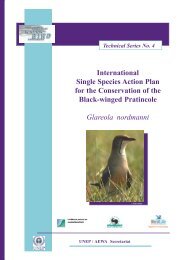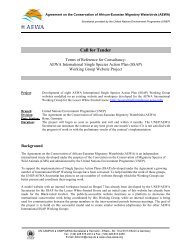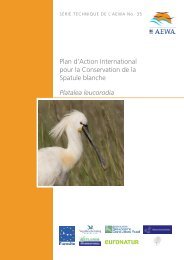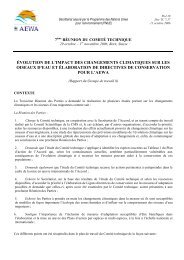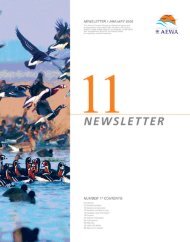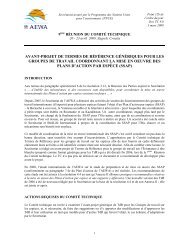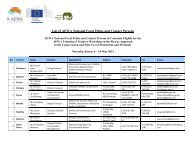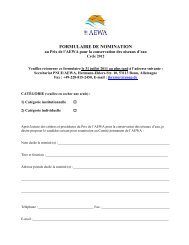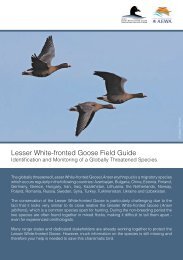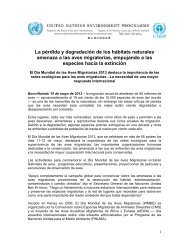International Single Species Action Plan for the ... - AEWA
International Single Species Action Plan for the ... - AEWA
International Single Species Action Plan for the ... - AEWA
Create successful ePaper yourself
Turn your PDF publications into a flip-book with our unique Google optimized e-Paper software.
<strong>AEWA</strong> Technical Series No. 36 - Annexes<br />
& D. Vangeluwe/ LIFE-Nature Project, reported on http://www.pikulska.net/). During <strong>the</strong><br />
winters of 2006/2007 and 2007/2008 a satellite-tagged and colour-ringed pair was observed at<br />
Lake Kerkini and Evros Delta. In total 14 colour-ringed individuals from <strong>the</strong> Fennoscandian<br />
population have been observed at Lake Kerkini and Evros Delta between 1995 and 2008 (T.<br />
Aaravak, pers. comm.). In early Mach 2008 54 individuals were recorded in Evros Delta (E.<br />
Makriyanni/LIFE-Nature projet, reported on http://www.piskulka.net).<br />
Hungary (EU)<br />
Vernacular name: Kis lilik<br />
Although counts are far lower than <strong>the</strong> tens of thousands of birds recorded be<strong>for</strong>e <strong>the</strong> 20th<br />
century crash of <strong>the</strong> Fennoscandian population, Hungary – notably Hortobágy National Park –<br />
continues to support significant numbers of staging Lesser White-fronted Geese. In autumn,<br />
<strong>the</strong> first birds arrive at Hortobágy fishponds in <strong>the</strong> first half of September and numbers<br />
usually peak in <strong>the</strong> second half of October, after which <strong>the</strong>re tends to be a slow decrease, with<br />
Lesser White-fronts dispersing with flocks of White-fronted Geese Anser albifrons. Most<br />
have generally left <strong>for</strong> <strong>the</strong>ir wintering grounds by mid-November, but departure may be<br />
delayed in mild seasons and a few individuals occasionally over-winter successfully, as was<br />
<strong>the</strong> case in <strong>the</strong> winter of 2000/2001, when four colour-ringed individuals, first observed in<br />
September 2000, were still present on 24 January 2001. The highest autumn counts <strong>for</strong> <strong>the</strong><br />
years 2001 and 2002 were 59 and 49 respectively. Similar numbers occur during spring<br />
migration, typically from mid-February to <strong>the</strong> second half of March. In 2001 and 2002 <strong>the</strong><br />
peak spring counts were 32 and 54 individuals (Tar 2004). However, unlike in Estonia,<br />
Finland and Norway, birds have not been recorded and identified individually in Hungary,<br />
and annual numbers of individuals are based mostly on <strong>the</strong> largest direct simultaneous counts<br />
from one site. This suggests that <strong>the</strong> total number of individuals occurring each year in<br />
Hungary may well be higher than <strong>the</strong> above figures indicate.<br />
Iran, Islamic Republic of<br />
Vernacular name: Ghaze pishani sepide Kuchak<br />
WCMC/UNEP 2004 states: “In <strong>the</strong> early 1970s, between 4,500 and 7,500 birds wintered in Iran,<br />
mainly in Miankaleh protected region, but <strong>the</strong>se disappeared suddenly in <strong>the</strong> late 1970s and, since<br />
<strong>the</strong>n, only small flocks have been observed in <strong>the</strong> country (Scott and Rose, 1996). Regular large<br />
flooding events in <strong>the</strong> area, due to <strong>the</strong> rising of <strong>the</strong> water level in <strong>the</strong> Caspian Sea, as well as<br />
hardening winters, may be leading to a redistribution of <strong>the</strong> wintering population in this country<br />
and Azerbaijan (Lorentsen et al., 1999).”<br />
The Iranian portion of <strong>the</strong> Mesopotamian marshes (see Iraq) is also a potentially important<br />
wintering area, but <strong>the</strong>re is no direct evidence to support this.<br />
Iraq<br />
Vernacular name: [in<strong>for</strong>mation missing]<br />
Evans 1994 records <strong>the</strong> species as <strong>for</strong>merly widespread and numerous, but currently <strong>the</strong> species is<br />
only present in small numbers.<br />
A satellite-tagged bird of <strong>the</strong> Western main subpopulation, ringed in <strong>the</strong> Polar Ural region of<br />
nor<strong>the</strong>rn Russia in August 2004, was tracked to Iraq during <strong>the</strong> winter of 2004/2005,<br />
providing <strong>the</strong> first proof of recent years that <strong>the</strong> species continues to winter in Iraq and <strong>the</strong><br />
first detailed evidence of <strong>the</strong> sites used. The bird stayed in <strong>the</strong> country from at least 24<br />
November until <strong>the</strong> last transmission from Iraq on 15 March. Spring migration began<br />
<strong>International</strong> <strong>Single</strong> <strong>Species</strong> <strong>Action</strong> <strong>Plan</strong> Lesser White-fronted Goose –Annexes<br />
XI



